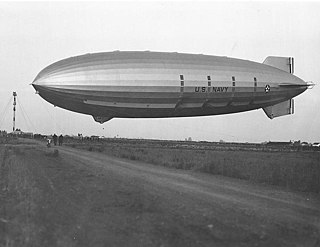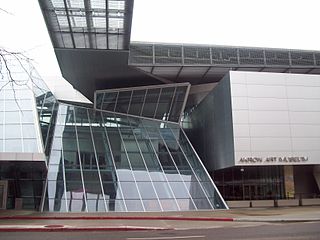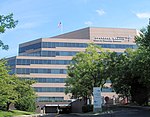
An airship or dirigible balloon is a type of aerostat or lighter-than-air aircraft that can navigate through the air under its own power. Aerostats gain their lift from a lifting gas that is less dense than the surrounding air.

USS Akron (ZRS-4) was a helium-filled rigid airship of the U.S. Navy, the lead ship of her class, which operated between September 1931 and April 1933. It was the world's first purpose-built flying aircraft carrier, carrying F9C Sparrowhawk fighter planes, which could be launched and recovered while it was in flight. With an overall length of 785 ft (239 m), Akron and her sister ship Macon were among the largest flying objects ever built. Although LZ 129 Hindenburg and LZ 130 Graf Zeppelin II were some 18 ft (5.5 m) longer and slightly more voluminous, the two German airships were filled with hydrogen, and so the two US Navy craft still hold the world record for the largest helium-filled airships.

Akron is a city in and the county seat of Summit County, Ohio, United States. At the 2020 census, the city proper had a total population of 190,469, making it the fifth-most populous city in Ohio and 136th-most populous city in the United States. The Akron metropolitan area, covering Summit and Portage counties, had a population of 702,219. It is located on the western edge of the Glaciated Allegheny Plateau in Northeast Ohio about 40 miles (64 km) south of downtown Cleveland.

Moffett Federal Airfield, also known as Moffett Field, is a joint civil-military airport located in an unincorporated part of Santa Clara County, California, United States, between northern Mountain View and northern Sunnyvale. On November 10, 2014, NASA announced that it would be leasing 1,000 acres (400 ha) of the airfield property to Google for 60 years.

USS Macon (ZRS-5) was a rigid airship built and operated by the United States Navy for scouting and served as a "flying aircraft carrier", carrying up to five single-seat Curtiss F9C Sparrowhawk parasite biplanes for scouting or two-seat Fleet N2Y-1s for training. In service for less than two years, the Macon was damaged in a storm and lost off California's Big Sur coast in February 1935, though most of the crew were saved. The wreckage is listed as the USS Macon Airship Remains on the U.S. National Register of Historic Places.

A hangar is a building or structure designed to hold aircraft or spacecraft. Hangars are built of metal, wood, or concrete. The word hangar comes from Middle French hanghart, of Germanic origin, from Frankish *haimgard, from *haim and gard ("yard"). The term, gard, comes from the Old Norse garðr.

The Goodyear Blimp is any one of a fleet of airships operated by the Goodyear Tire and Rubber Company, used mainly for advertising purposes and capturing aerial views of live sporting events for television. The term blimp itself is defined as a non-rigid airship—without any internal structure, the pressure of lifting gas within the airship envelope maintains the vessel's shape.

Goodyear Aerospace Corporation (GAC) was the aerospace and defense subsidiary of the Goodyear Tire and Rubber Company. The company was originally operated as a division within Goodyear as the Goodyear Zeppelin Corporation, part of a joint project with Luftschiffbau Zeppelin, leading to the development of rigid airships in the United States. As part of the failing relationship between the US and Germany in the era prior to World War II, the division was spun off as Goodyear Aircraft Company in 1939. The company opened a new factory in Arizona in 1941 which produced subassemblies, including subcontracted airframe construction and the design of the Goodyear F2G Corsair and Goodyear Duck.

Hangar No. 1 is an airship hangar located at Naval Air Engineering Station Lakehurst in Manchester Township, in Ocean County, New Jersey, United States. It was the intended destination of the rigid airship LZ 129 Hindenburg prior to the Hindenburg disaster on May 6, 1937, when it burned while landing. Built in 1921, it is one of the oldest surviving structures associated with that period's development of lighter-than-air flight. It was designated a National Historic Landmark in 1968.

Hangar One is one of the world's largest freestanding structures, covering 8 acres at Moffett Field near Mountain View, California in the San Francisco Bay Area.
Airship hangars are large specialized buildings that are used for sheltering airships during construction, maintenance and storage. Rigid airships always needed to be based in airship hangars because weathering was a serious risk.

The Goodyear GZ-20/20A was a class of non-rigid airship or blimp introduced in 1969 by The Goodyear Tire and Rubber Company in the United States as its signature promotional aircraft, the Goodyear Blimp. The design is based on the previous Goodyear GZ-19 class. The GZ-20 featured a larger envelope to carry the "Super-Skytacular" advertising night sign and more powerful engines. The GZ-20s were the mainstay of Goodyear's airship operations until 2017, when they were replaced with the new Zeppelin NT semi-rigid airship.

Karl Arnstein was one of the most important 20th century airship engineers and designers in Germany and the United States of America. He was born in Prague, Bohemia to Jewish parents. He developed stress analysis methods that have been incorporated into bridges, airships and airplane materials. Before his involvement in airships he was one of the main engineers in building the Swiss Langwieser Viaduct.

Dr. Wolfgang Benjamin Klemperer was born in Dresden, Germany, the son of the Austrian nationals Leon and Charlotte Klemperer. He was in his time a prominent aviation and aerospace scientist and engineer, who ranks among the pioneers of early aviation.
A mooring mast, or mooring tower, is a structure designed to allow for the docking of an airship outside of an airship hangar or similar structure. More specifically, a mooring mast is a mast or tower that contains a fitting on its top that allows for the bow of the airship to attach its mooring line to the structure. When it is not necessary or convenient to put an airship into its hangar between flights, airships can be moored on the surface of land or water, in the air to one or more wires, or to a mooring mast. After their development mooring masts became the standard approach to mooring airships as considerable manhandling was avoided.
The Weeksville Dirigible Hangar is an airship manufacturing, storage and test facility originally built by the United States Navy in 1941 for servicing airships conducting anti-submarine patrols of the US coast and harbors. It is located on the former Naval Air Station Weeksville in Elizabeth City, North Carolina, approximately 2 miles southeast of the present day Coast Guard Air Station Elizabeth City.
The ZRCV was a large dirigible aircraft carrier proposed by the Lighter-than-Air Bureau of the United States Department of the Navy and the Goodyear-Zeppelin Corporation. It would have been a 9.55-million-cubic-foot (270,000 m3) airship designed to carry nine Douglas-Northrop BT–1 dive bombers.
In the nation's quest to provide security along its lengthy coastlines, air reconnaissance was put forth by the futuristic Rear Admiral William A. Moffett. Through his efforts, two Naval Air Stations were commissioned in the early 1930s to port the Naval Airships (dirigibles) which he believed capable of meeting this challenge.

The Akron-class airships were a class of two rigid airships constructed for the US Navy in the early 1930s. Designed as scouting and reconnaissance platforms, the intention for their use was to act as "eyes for the fleet", extending the range at which the US Navy's Scouting Force could operate to beyond the horizon. This capability was extended further through the use of the airships as airborne aircraft carriers, with each capable of carrying a small squadron of airplanes that could be used both to increase the airship's scouting range, and to provide self-defense for the airship against other airborne threats.

Paul W. Litchfield was an American inventor, industrialist, and author. He served as President, Chairman, and the first CEO of the Goodyear Tire & Rubber Company and the founder of the town of Litchfield Park, Arizona and the city of Goodyear, Arizona. Among his many accomplishments as chairman was the establishment of a research and development department that produced the first practical airplane tire, long-haul conveyor belts, hydraulic disc brakes for airplanes, the first pneumatic truck tire, and a bullet-sealing fuel tank for military airplanes. Litchfield was also the author of books on air power, trucks, employee relations, and business.




















